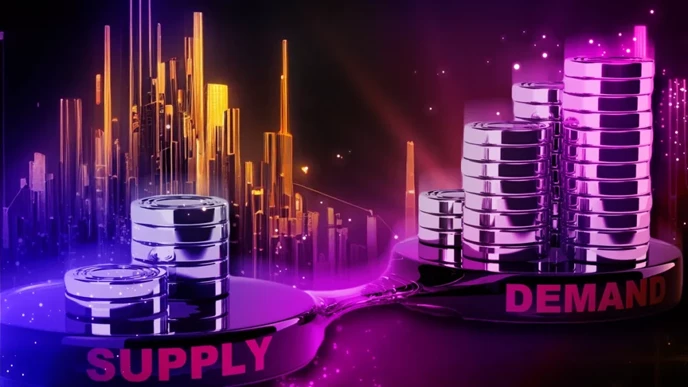What is Price Discovery and How Does It Work?

Have you ever wondered how a stock, cryptocurrency, commodity, or anything else with value settles on price?
Some assets have been around for a long time while others are very new. But all are undergoing a constant process called Price Discovery.
What is Price Discovery?
Price discovery refers to the mechanism by which the market establishes the equitable price of a commodity or asset by means of the interaction between buyers and sellers, encompassing a thorough evaluation of all available information and an analysis of the supply and demand within the market.
In financial markets, price discovery happens through the continuous buying and selling of securities, such as stocks or bonds, by investors and traders. As buyers and sellers trade securities, the prices of those securities fluctuate based on market sentiment and changes in supply and demand. These price fluctuations eventually lead to an equilibrium price, which is the price at which buyers and sellers are willing to transact the most amount of securities.
In the market, the spot price that satisfies the main players can be found at the point where the supply and demand curves intersect.

The process of discovering prices is not new and has been used for centuries. It's commonly seen in auctions for art and antiques, car dealerships, local farmers' markets, and other marketplaces where participants have to bargain to agree on prices. Moreover, this mechanism is crucial in stock and cryptocurrency exchanges.
Today, with advanced technologies and easier access to capital, price discovery has become an essential tool for traders and investors.
How Does Price Discovery Work?
In the market, when there is more demand for a product than the available supply, the price goes up due to market forces. Conversely, when there is an oversupply of the product and few buyers, the price drops until the supply and demand reach a balance, which is called the equilibrium point.
This same process occurs in reverse. If there is an excess supply of a product and not enough demand, sellers will lower prices until the excess is sold. The support and resistance price levels in the market reflect the equilibrium between supply and demand.
This process of finding the optimal selling point is known as price discovery and it is a continuous activity in the market.
Factors Affecting Price Discovery

Supply and demand are obviously the most critical factors that determine price discovery. Yet, there are many other aspects that have their say in the final price of every asset.
Some of these aspects include:
1. Risk management strategies
Buyers' attitude to risk can greatly influence price discovery. For example, buyers may be ready to accept high risk in exchange for much higher profits. In this case, they would also be ready to bear additional expenses so as to secure their positions.
This, in turn, will lead to higher spot prices as the assets will be overbought. At this, one may expect the asset price to fall in the upcoming days or weeks.
In order to reduce risks and increase the chances of profitable deals, traders set up stop and limit orders. This technique makes it possible to quit the game in case of a negative scenario.
2. Volatility
Volatility is closely related to risks. The higher the volatility of a given asset or a market as a whole, the higher the chances of both hitting the jackpot and losing everything.
In conditions of high volatility, technical and fundamental analyses enable traders to find the right assets and to determine prices to buy or sell them. Thus, the price discovery process helps them get profits.
3. Available information
There is a popular rule beloved by many traders: buy the rumor, sell the news. At this, the amount of information that traders can access significantly influences price discovery.
For example, large market players may start rumors about major updates to their products. This can make traders agitated and drive the asset price upward.
By the release date, the asset gets overbought which leads to the successive price drop.
4. Liquidity
The higher the liquidity of a given asset, the easier one can cash it out without affecting the market price. At this, liquidity providers or market makers play an important role in the price discovery process.
These financial institutions or individuals hold large amounts of various assets ready to distribute them on demand. Thus, they contribute to higher market stability since the difference between the buy and sell prices they offer is generally very low.
Price Discovery vs Valuation
Price discovery is often confused with valuation, though these terms have slightly different meanings.
While price discovery refers to real market-driven forces, valuation operates with presumed indices. This analytical princess helps traders to estimate how much a given asset could be worth in specific circumstances, but it doesn’t imply any real deals with this asset.
Similar to price discovery, valuation heavily depends on the same market factors like supply and demand, volatility, etc. Yet, it can be of great assistance to traders and investors helping them to identify profitable deals.
For example, one may compare real market value to valuation and identify if a given asset is underpriced or overpriced. At this, it’s possible to forecast whether the price of the asset will go up or down and make relevant trading decisions.
Price Discovery in Crypto
In spite of technological advantages, the price discovery mechanism is pretty much the same for cryptocurrency markets.
The supply and demand for Bitcoin or any other digital asset drive their prices up or down while high volatility provides traders with greater opportunities.
What makes crypto different from traditional financial markets is higher transparency and liquidity. Traders have access to relevant price information and can make orders 24/7. The liquidity varies from one crypto asset to another. Yet, the recent invention of liquidity pools has solved the problem of low liquidity for rare tokens as well.
All-in-all, price discovery is a fundamental process in the world of cryptocurrencies. Just like in the TradFi sector, it determines the value of digital assets and ensures that both buyers and sellers come to a mutual agreement.
Join The Leading Crypto Channel
JOINDisclaimer:Please note that nothing on this website constitutes financial advice. Whilst every effort has been made to ensure that the information provided on this website is accurate, individuals must not rely on this information to make a financial or investment decision. Before making any decision, we strongly recommend you consult a qualified professional who should take into account your specific investment objectives, financial situation and individual needs.

Kate
Kate is a blockchain specialist, enthusiast, and adopter, who loves writing about complex technologies and explaining them in simple words. Kate features regularly for Liquid Loans, plus Cointelegraph, Nomics, Cryptopay, ByBit and more.

Development
Knowledge
Subscribe To Newsletter
Stay up-to-date with all the latest news about
Liquid Loans, Fetch Oracle and more.
Copyright © 2024 Crave Management.
All Rights Reserved.

The LL Librarian
Your Genius Liquid Loans Knowledge Assistant




